Austin Princess
| Austin Princess | |
|---|---|
|
| |
| Overview | |
| Manufacturer | Austin/Vanden Plas (BMC) |
| Also called |
Princess (1957–1960)[1] Vanden Plas Princess (1960–1968) [1] |
| Production | 1947–1968 |
| Body and chassis | |
| Class | Full-size luxury car |
| Body style |
4-door saloon 4-door limousine |
| Related | Austin Sheerline |
| Chronology | |
| Predecessor | Austin 28 Ranelagh |
| Successor | Daimler DS420 |
The Austin Princess is a series of large luxury cars that were made by Austin and its subsidiary Vanden Plas from 1947 to 1968.
The Princess name was also used as follows:
- From October 1959 the name Princess was used on a deluxe version of BMC's mid-sized 6/99 & 6/110 and A99 & A110 cars.
- From October 1962 Princess was used on a deluxe version of the Austin/Morris 1300.
- From September 1975 Princess was used as a name for mass-produced family cars in Leyland's 1800/2200 former Austin/Morris/Wolseley range.[2]
Naming
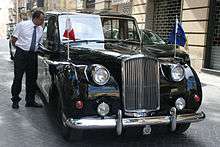
The first Austin Princess A120 was launched in 1947[3] as the most expensive flagship model in the Austin range at the same time as the A110 Austin Sheerline (designed during the war) which body was built on the same chassis at Longbridge, the A110 produced 10 less horsepower being fitted with a single carburetter. Both cars always had bodies that were massive and heavy in appearance. The Princess (model code A120) featured a body by the coachbuilder Vanden Plas and was a large saloon or limousine. The car was offered with two distinct interiors. The "DM" or limousine type had a sliding glass partition between the driver and rear passengers plus picnic tables, and the "DS" was the saloon. The saloons were successful as a top-executive car, many Princesses (and Sheerlines, for that matter) were bought for civic ceremonial duties or by hire companies as limousines for hire. The standard saloon weighed almost two tons, was 16 ft 9 inches long and 6 feet 1¼ inches wide on a 10-foot 1¼-inch (the short) wheelbase.
The Princess model was updated over the years through Mark I (A120), Mark II (A135) and Mark III versions, the largest variation being the introduction of the long-wheelbase version in 1952 with a longer body and seven seats: apart from that the bodywork and running gear hardly changed, nor did the 4-litre straight-6 engine. The radiator was fairly upright in old-fashioned style and the car had separate front wings, but these cars were always more modern in style than the equivalent-sized Bentley or Rolls-Royce and, for the saloon, the price was little more than two-thirds of the Rolls-Royce.
From August 1957 the Austin part of the badging was dropped so it could be sold by Nuffield dealerships. From May 1960, the Vanden Plas name was added in front of "Princess".
Austin Princess I, II and III
| Austin A120-135 Princess I, II and III | |
|---|---|
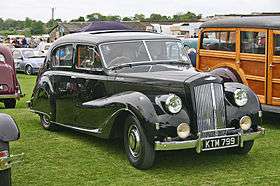 Austin A135 Princess II (DS3) | |
| Overview | |
| Manufacturer | Austin (BMC) |
| Production |
Princess 1 (DM2/DS2): 1947–1950 [4] Princess II (DM3/DS3): 1950–1953 [4] Princess III (DM5/DS5): 1953–1956 [4] |
| Powertrain | |
| Engine | 3995 cc 6-cylinder overhead-valve |
| Dimensions | |
| Wheelbase | 132 in (3,353 mm)(long-wheelbase)[5] |
| Length | 215 in (5,461 mm)(long-wheelbase)[5] |
| Width | 74 in (1,880 mm)[5] |
| Height | 70 in (1,778 mm)[5] |
In 1947, Austin produced two virtually identical chassis, one for the A110 (later A125 Sheerline, built entirely by Austin at their Longbridge factory) and the A120 (later A135) chassis used by Vanden Plas to produce the Princess at their Kingsbury works (North London). Although Vanden Plas was by now wholly owned by Austin and much of the running gear and instrumentation was the same in the two cars, the Princess was the Austin flagship, with a higher specification leather, wool and burr walnut interior. The original Princess was powered by a 3.5-litre straight six engine. This was enlarged to a 4.0-litre unit without further modifications. The Princess was often built to order. Customers could specify the colour required and a range of different setups were available. These included triple or single carburetors and twin or single exhaust systems. Whilst the sportier multiple carb version performed better, it tended to achieve only 12 to 14 mpg. The single carb however gave slightly better fuel consumption . Performance was very good for a car of its size, with a top speed of 90 mph (140 km/h) and acceleration 0 to 60 mph of 20 seconds. In 1950, the Limousine version was introduced. The chassis length and passenger area were enlarged to enable a pair of drop down seats to be mounted on the rear of the front seats and a glass division was standard. All of these early cars are now extremely rare, especially the saloon versions. Many of the saloons were converted for use as taxis in the late 1950s, fitted with Perkins diesel engines to overcome economy issues. The 3993cc 6-cylinder engine was also fitted, as a petrol option seldom taken up, to the Austin and Morris normal-control (i.e. "bonneted") WEK and WFK commercial vehicles.
During the life of this model (in 1952), Austin became part of the British Motor Corporation (BMC).
-

Austin A135 Princess II (DS3)
Austin Princess IV and Princess IV
| Austin Princess IV (1956–57) Princess IV (1957–1959) | |
|---|---|
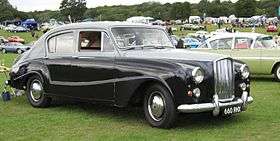 1958 Princess IV | |
| Overview | |
| Manufacturer | Vanden Plas (BMC) |
| Production | 1956–1959 |
| Body and chassis | |
| Class | large luxury car[6] |
| Body style | 4-door saloon[6] |
| Powertrain | |
| Engine | 3995 cc 6-cylinder overhead-valve |
| Transmission | 4-speed automatic[6] |
| Dimensions | |
| Wheelbase | 121¾ in 3,092.4 mm (121.75 in)[6] |
| Length | 5,105.4 mm (201 in)[6] |
| Width | 73¾ in 1,873.2 mm (73.75 in)[6] |
| Height | 65¾ in 1,670.0 mm (65.75 in)[6] |
| Kerb weight | 39¾ Cwt 2,019–2,019 kg (4,452–4,452 lb)[6] |
| Chronology | |
| Predecessor | Princess 125 and 135 |
| Successor | none |
The Austin Princess IV was introduced in 1956.[7] Offered in Saloon and Touring Limousine models,[8] this replacement for the former Sheerline and A135 only stayed in the catalogue until 1959; 200 were built.[9]
The last A135 Mark 3 had been priced at five times the price of an Austin A30. The new IV had to be priced at 6.5 times the price of an Austin A30, at which price there was almost no demand. The name was shortened in August 1957 when the car lost its "Austin" designation, now being branded simply as the Princess IV [10] so it might be sold by either Morris or Austin dealers. The Times tested the Princess IV and reported on it at some length in early February 1959.[6]
The Princess IV was discontinued in 1959 and replaced in the catalogue by a much smaller model, an upgraded Austin Westminster (Pininfarina-designed Vanden Plas Princess see below), which retailed at little more than 40 per cent of the Mark IV's price.
An Austin Princess IV was road tested by The Autocar magazine on 3 October 1958, as No.1703 in the series. The engine was rated at 150 bhp (gross) and it returned a maximum speed of 98.7 mph, under the test conditions prevailing.
.jpg) |
Austin Princess, Princess and Vanden Plas Princess Long Wheelbase Limousine (or Saloon)
| Austin Princess Princess Vanden Plas Princess Long Wheelbase Limousine (or Saloon) | |
|---|---|
.jpg) | |
| Overview | |
| Production | 1952–1968 [4] |
| Powertrain | |
| Engine | 3995 cc 6-cylinder overhead-valve |
| Dimensions | |
| Wheelbase | 132 in (3,353 mm)(long-wheelbase)[11] |
| Length | 215 in (5,461 mm)(long-wheelbase)[11] |
| Width | 73 in (1,854 mm)[11] |
| Height | 70 in (1,778 mm)[11] |
The Austin A135 Princess Long Wheelbase Saloon (DS6) and Limousine (DM4) were introduced in 1952.[4] The automatic transmission and power steering from Princess IV were fitted from 1956.[12] The marque name was changed from Austin to Princess in August 1957,[12] and then to Vanden Plas [12] from July 1960.[13] The long wheelbase models continued to be built by hand in limited numbers as the Vanden Plas 4-Litre Princess Limousine, until 1968. All now being parts of British Leyland, the Jaguar Mark X-based Daimler DS420 was initially produced at the Vanden Plas works in Kingsbury, North London then replaced the Vanden Plas Princess within the new, slightly rationalised range. This had been foreseen in 1966 when British Motor Holdings (BMH) had brought BMC and Jaguar together, and stopped development at Vanden Plas of the potential successor car. The limousine was luxuriously appointed with lots of polished wood, optional mohair rugs and radio with controls in the armrest. Among the long list of available extras were monograms and a flagstaff. The driving compartment was separated from the rear of the car by a division with an optional telephone for the passengers to communicate with the driver. The driving seat was finished in leather but the rear seats were trimmed in cloth, the usual arrangement on many luxury cars of the time. Though not as durable as leather, cloth was considered kinder to passengers' clothes. To increase seating capacity two occasional seats could be folded out of the floor.
The car had independent coil suspension at the front with semi elliptic leaf springs and anti roll bar at the rear. The cam and peg type steering gear had optional power assistance.
An Austin A135 Princess Long-wheelbase Limousine tested by The Motor magazine in 1953 had a top speed of 79 mph (127 km/h) and could accelerate from 0-60 mph (97 km/h) in 23.3 seconds. A fuel consumption of 15.1 miles per imperial gallon (18.7 L/100 km; 12.6 mpg-US) was recorded. The test car cost £2480 including taxes.[5]
An automatic Limousine was tested by the British magazine The Motor in 1962 and had a top speed of 86.2 mph (138.7 km/h) and could accelerate from 0-60 mph (97 km/h) in 23.5 seconds. A fuel consumption of 15.8 miles per imperial gallon (17.9 L/100 km; 13.2 mpg-US) was recorded. The test car cost £3,473 including taxes.[11]
.jpg)
-

Princess DM4 conversion
from the sign in the photograph:
"Delivered to the Royal Mews in 1972 this car was one of the last ever Princesses. Although they went out of production in 1969 two were kept aside, as an alternative to the vastly more expensive Daimler limousines, for the use of junior members of the royal family on official engagements. For this purpose they were repainted in Royal Colours (royal claret over black)
In March 1974 this vehicle was returning Princess Anne to Buckingham Palace following a film premiere when it was brought to a halt by a white Ford Escort in the Mall. The Princess's bodyguard and chauffeur were both shot and injured in the ensuing struggle with a would-be kidnapper. Princess Anne was fortunately unharmed despite being manhandled by the assailant"
Princess 3-litre and Vanden Plas Princess 3-litre
| Princess 3-litre (1959–1960) Vanden Plas Princess 3-litre (1960–1964) | |
|---|---|
|
Vanden Plas Princess 3-litre | |
| Overview | |
| Production | 1959–1964 |
| Body and chassis | |
| Body style | 4-door saloon |
| Powertrain | |
| Engine | 2.9 L C-Series I6 |
| Dimensions | |
| Wheelbase |
84 in (2,134 mm)[14] 1959 – 1961 86 in (2,184 mm)[15] 1961 – 1964 |
| Length | 187.75 in (4,769 mm)[14] |
| Width | 68.5 in (1,740 mm)[14] |
| Height | 59 in (1,499 mm)[14] |
In October 1959 a new Austin A99 Westminster-based model was launched [16] under the name Princess 3-litre.[1] From July 1960[7] these vehicles bore the Vanden Plas name which became a badge-engineered brand in its own right (rather than being known as coachbuilder for the cars of other manufacturers). The car was a great deal smaller and less than 44 per cent of the price of the previous Princess IV Saloon and was instead largely identical to the Austin A99 Westminster and other models using the same Pininfarina-designed bodyshell. It featured a new Vanden Plas grille (fairly square, with a thick surround and vertical slats), round headlamps, and horn grilles on the front. The interior was lavish in typical Vanden Plas style, featuring burr walnut wood trim, leather seats and panels, and high-quality carpeting. A division between the driver and the rear compartment was an optional extra. Power was a 3-litre unit developing 108 hp (81 kW).[14]
A 3-litre Vanden Plas Princess with automatic transmission was tested by the British magazine The Motor in 1961 and had a top speed of 99.3 mph (159.8 km/h) and could accelerate from 0-60 mph (97 km/h) in 16.1 seconds. A fuel consumption of 21.1 miles per imperial gallon (13.4 L/100 km; 17.6 mpg-US) was recorded. The test car cost £1,467 including taxes.[14]
This model was replaced in 1961 by the Vanden Plas Princess 3-litre Mark II. Styling was similar but the wheelbase was two inches (5 cm) longer[15] and anti-roll bars were added to the suspension at both ends of the car.[15] The engine was uprated to 120 hp (89 kW). Better brakes were fitted, and interior improvements included built-in drop-down "picnic tables" for the rear seat passengers. Options now included "Smith's air-conditioning".[15]
This model was discontinued in 1964.
-

Vanden Plas Princess 3-litre Mark II
-

Vanden Plas Princess 3-litre Mark II - rear view showing finned tail
-

Vanden Plas Princess 3-litre Mark II
Vanden Plas Princess 4-litre R
| Vanden Plas Princess 4-Litre R | |
|---|---|
 1967 Vanden Plas Princess 4-litre R | |
| Overview | |
| Production | 1964–1968 |
| Powertrain | |
| Engine | 3909 cc 6-cylinder IOE engine |
The Vanden Plas Princess 4-litre R with its Rolls-Royce all-aluminium 175 bhp engine was announced in August 1964. With an unusually high power to weight ratio the car gave easy cruising at 90+ mph and was capable of 112 mph.[17]
The big change was under the bonnet where there was a result of more than two years technical collaboration between BMC and Rolls-Royce. The aluminium Rolls-Royce FB60 engine was a short-stroke version of the Rolls-Royce Military B: 4, 6 and 8 cylinder units of which more than 30,000 had already been produced.[17] The 6-cylinder engine weighed only 450 lb (204 kg).[18] Its cubic capacity was 3.909 litres (239 cu in). Over-square: bore was 95.25 mm (3.8 in), stroke 91.44 mm (3.6 in); with a 7.8:1 compression ratio its output was 175 bhp (130 kW; 177 PS) @4,800 rpm. Twin SU carburettors were fitted. Both block and head were aluminium, tappets were hydraulic self-adjusting operating on overhead inlet and side exhaust valves. The counterbalanced crankshaft ran in seven bearings.[19]
The 4-litre R was replete with polished walnut fascia padded top and bottom, hide upholstered seats with fully reclinable backs and polished picnic tables for the rear passengers. A new automatic transmission was provided, Borg-Warner model 8, its first use in a British car and Hydrosteer variable ratio power steering accompanied wider tyres. Externally the fog lamps were moved up by the grille, the hindquarters tidied extended and adjusted to look more substantial and the tailfins replaced by small corner-ridges.[17]
Pricing
The background to the pricing was that from April 1961 tax relief on company cars was allowed only up to £2,000.[18]
The new car was priced on a par with the bulbous Jaguar Mark X (albeit only the manual transmission model of the Jaguar), just 50 per cent more than its apparent predecessor the 3-litre car. It was a major change of market positioning aimed at the growing prestige and executive market in Europe and the United States, but its close appearance to its predecessor, its pricing near to that of the Jaguar, which was both bigger, with a far more advanced chassis design, more prestigious though itself without a useful market in the United States, doomed it to failure.
- £1,346 (discontinued Vanden Plas Princess Mark II)
- £1,994 Vanden Plas Princess 4-litre R
- £2,022 Jaguar Mark X
- £5,517 Rolls-Royce Silver Cloud III[17]
Joint production capacity of 12,000 cars a year was provided, ( although actual production was never more than a fraction of this ) and final assembly and hand finishing was at the Vanden Plas works in Kingsbury London.[17]
The Vanden Plas Princess 4-litre R remained in production until 1968, just ahead of BMC's merge into British Leyland. About 6,555 were built. It was the only mass-produced civilian vehicle from another manufacturer ever to use a Rolls-Royce engine.[15]
-

Princess 4-litre "R"
with new shifted foglamps and wider tyres -

Rear view showing new horizontal lighting arrangement
-

Rear three-quarter view showing new more substantial shape
Rolls-Royce Java
This car was a result of a joint BMC / Rolls-Royce project for a smaller Bentley code-named Java. Prototypes were made using the Austin-engineered central portion of the Vanden Plas, with restyled Rolls Royce and Bentley panels front and rear. Neither of these models made it into production. Rolls-Royce withdrew from the venture. They had been covering the possibility that the survival of their motor car division might depend on providing a relatively compact mass-produced Rolls-Royce. However 1965's introduction of the Rolls-Royce Silver Shadow was a success.
Vanden Plas Princess 1100/1275/1300
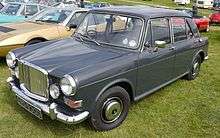
The Vanden Plas Princess 1100 was launched in 1963 as a luxury variant of the BMC ADO16.[20] Production of the Princess 1100 and subsequent 1275 and 1300 models ended in 1974 [1] with 43,741 examples produced.[21]
Princess (ADO71)
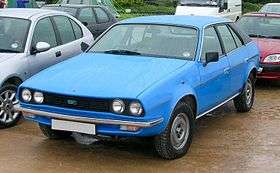
The final use of the "Princess" name was for the Princess 1800 / 2200 of 1975–78 and the Princess 2 1700 / 2000 / 2200 of 1978–81. This was not badged as an Austin on the home market (although it was badged as such in New Zealand), but was sometimes confused with one because for the first year of its life it was marketed (variously) as the Austin, Morris, and Wolseley 18–22 Series. It was succeeded by the Austin Ambassador in 1982 and thus marked the end of the Princess, although the Vanden Plas name continued as the most luxurious trim level in the Rover SD1 range.
References
- 1 2 3 4 Marques : Vanden Plas, www.aronline.co.uk Retrieved on 13 January 2013
- ↑ Leyland's Princess The Times, Thursday, Sep 11, 1975; pg. 27; Issue 59498; col A
- ↑ New Austin Cars The Times, Friday, Mar 14, 1947; pg. 6; Issue 50709; col G
- 1 2 3 4 5 Sheerline and Princess models, www.austinsheerlineprincess.org Retrieved on 11 March 2013
- 1 2 3 4 5 "The Austin A135 Princess Long-wheelbase Limousine Road Test". The Motor. July 29, 1953.
- 1 2 3 4 5 6 7 8 9 Power And Control Of The Princess The Times Tuesday, Feb 03, 1959; pg. 5; Issue 54375.
- 1 2 New Austin Model The Times, Wednesday, Oct 03, 1956; pg. 5; Issue 53652; col F
- ↑ Advertisement for the Austin Princess IV, The Illustrated London News, March 9, 1957, page 2
- ↑ Michael Sedgwick & Mark Gillies, A-Z of Cars 1945–1970, page 26
- ↑ London Motor Show The Times, Tuesday, Oct 15, 1957; pg. 17; Issue 53972
- 1 2 3 4 5 "The Vanden Plas 4-Litre Princess Limousine". The Motor. April 11, 1962.
- 1 2 3 Graham Robson, The Cars of BMC, page 131
- ↑ Princess Models The Times, Tuesday, Jul 12, 1960; pg. 7; Issue 54821; col F
- 1 2 3 4 5 6 "The Vanden Plas Three-litre Princess". The Motor. 5 April 1961.
- 1 2 3 4 5 "Used Car Test: 1964 Vanden Plas Princess R". Autocar. Vol. 128 nbr 3761. March 14, 1968. pp. 50–51.
- ↑ Vanden Plas 4 Litre R, www.uniquecarsandparts.com.au Retrieved on 6 February 2013
- 1 2 3 4 5 Rolls-Royce Engine In New B.M.C. 112 mph Saloon. The Times, Wednesday, Aug 19, 1964; pg. 5; Issue 56094
- 1 2 Rolls-B.M.C. Marriage Proving A Happy One from Our Motoring Correspondent-Crewe, Feb. 28. The Times, Monday, Mar 01, 1965; pg. 7
- ↑ Display Advertising BMC. The Times, Wednesday, Aug 19, 1964; pg. 7; Issue 56094
- ↑ Gallery : BMC 1100/1300 timeline, www.aronline.co.uk Retrieved on 13 January 2013
- ↑ Michael Sedgwick & Mark Gillies, A-Z of Cars 1945–1970, page 211
External links
- 1957 Austin Princess IV Sales Brochure Saloon and Touring Limousine and Austin Long Wheelbase Limousine (or Saloon)
- 1958 Austin Princess IV Saloon
- Photos of earlier production